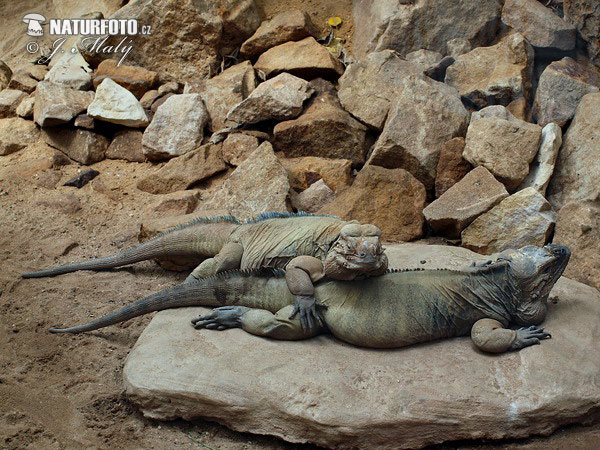
(2004), "The Evolution of Iguanas: An Overview of Relationships and a Checklist of Species", Iguanas: Biology and Conservation, University of California Press, pp.

Proceedings of the American Philosopher's Society. Catalogue of American Amphibians and Reptiles. Cyclura onchiopsis Cope Navassa Island Rhinoceros Iguana. "The large iguanas of the Greater Antilles". Noted herpetoculturist David Blair maintains that some of these animals may remain in captivity somewhere in the world, but admits they would be very aged specimens. Dr Robert Powell's research while at the Department of Natural Sciences, Avila College, Kansas City, Missouri, suggests that the iguanas disappeared before the introduction of feral species, as a result of habitat change or hunting by man. Military occupation of the island prior to the 1960s may have been responsible for its demise, or years of mining guano for fertilizer the introduction of feral dogs, goats, and rats may have also been to blame. An extensive search again in 1999 failed to find any iguanas. Hey yo Today I took some time to hang out with 2 of our rhino iguanas(Cyclura cornuta), Sully and Tammy. An entomologist visited the island again in 1986 and saw no signs of any iguanas, although he was not specifically looking for them.
#Rhinoceros iguana skin
A large lizard, they vary in length from 60 to 136 centimetres (24 to 54 in), and skin colours range from a. Navassa Island was visited in 19 and no animals were present. The rhinoceros iguana ( Cyclura cornuta ) is an endangered species of iguana that is endemic to the Caribbean island of Hispaniola (shared by Haiti and the Dominican Republic) and its surrounding islands. These lizards varied in length from 60 to 136 cm (24 to 54 in), with skin colors ranging from a steely gray to a dark green and even brown, and possessed a bony-plated pseudo-horn or outgrowth which resembled the horn of a rhinoceros.
#Rhinoceros iguana full
In 1999, Dr Robert Powell wrote that, based on these prior studies, this animal should be elevated to full species status, distinct from C. cornuta on the basis of this single character (distinctly smaller dorsolateral scales) (plus perhaps other modalities), but to do so would obscure its obvious affinities with the latter species.” The IUCN still considers the iguana to be its own species C.
#Rhinoceros iguana pdf
In 1977, Schwartz and Carey wrote “It is even conceivable that onchiopsis should be considered a species distinct from C. Request PDF Genetic structure of Rhinoceros Rock Iguanas, Cyclura cornuta, in the Dominican Republic, with insights into the impact of captive facilities and the taxonomic status of Cyclura on. 5.2K 187K views 3 years ago iguana rhinocerosiguana rhinoiguana The rhinoceros iguana (Cyclura cornuta) is one of the coolest lizards in the world. cornuta 90 years later, based on the writings of Thomas Barbour and Robert Mertens, yet presented numerous data relating to scale count that suggested otherwise. Herpetologists Albert Schwartz and Richard Thomas officially reclassified it as a subspecies of C. nigerrima, due to the animal's almost black coloration. In 1885, Cope first described the lizard as two species in the same paper: C. The species was first described by American herpetologist Edward Drinker Cope in 1885. Its specific name, cornuta, is the feminine form of the Latin adjective cornutus, meaning "horned" and refers to the horned projections on the snouts of males of the species. The males become sexually mature at 4-5 years of age, while the females reach sexual maturity when they are 2-3 years old.Cyclura cornuta onchiopsis, the Navassa Island iguana, was a subspecies of rhinoceros iguana that was found on the Caribbean island of Navassa. They guard their nesting sites and incubate their eggs for around 85 days. They lay approximately 17-18 eggs within 40 days after mating. A male may have several mating partners.įemales dig deep burrows, which may measure 1.5 meters long. Once a female iguana responds to the male’s mating display, the male mounts the female. Male rhino iguanas use rapid movements of their head and body to intimidate other males as well as to attract females. The mating season usually starts in late May and may extend through June.

They also use these anatomical adaptations to escape from the grasp of enemies or predators.


 0 kommentar(er)
0 kommentar(er)
